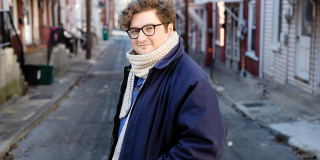
Lehigh art historian Florencia San Martin curates an exhibition in Chile to commemorate the ongoing impact of the 1973 US-backed military coup.
On September 11, 1973, the Chilean military, led by General Augusto Pinochet, staged a US-backed coup against the democratically-elected socialist President Salvador Allende.
For nearly the next two decades, the people of Chile would live under a military dictatorship where more than 3,000 people were killed or disappeared—essentially erased from time—and close to 38,000 became political prisoners, most of them victims of torture.
 To commemorate the ongoing impact of the coup on its 5oth anniversary, the Chilean Ministry of Culture commissioned Lehigh University assistant professor of art history Florencia San Martín to create the curatorial framework of an art exhibition at the National Center of Contemporary Art in Chile, and to work collectively with artist Claudia Del Fierro, who was invited to relate the curatorial framework to the community. The exhibition is open to the public from November 4 2023 through March 24, 2024.
To commemorate the ongoing impact of the coup on its 5oth anniversary, the Chilean Ministry of Culture commissioned Lehigh University assistant professor of art history Florencia San Martín to create the curatorial framework of an art exhibition at the National Center of Contemporary Art in Chile, and to work collectively with artist Claudia Del Fierro, who was invited to relate the curatorial framework to the community. The exhibition is open to the public from November 4 2023 through March 24, 2024.
The title of the exhibition, Todavía somos el tiempo: arte y resistencia a 50 años del golpe (We are still time: art and resistance 50 years after the coup), takes its name from a verse from the poem “Aniversario” by the late Chilean poet Gabriela Mistral.
“I read ‘We are still time’ as a statement in which time is memory, meaning that memory should be an integral part of the ways we live in the present,” San Martín said. “While Mistral wrote the poem before the coup, I thought it was important to bring her for the 50th anniversary since the issue of memory is, in my view, key to fighting colonialism.”
For San Martín, colonialism isn’t just a relic of bygone centuries, but an ongoing global economic and political system in which advanced industrialized nations continue to exert influence and control over less developed or formerly colonized countries.
In this “neocolonial” world system, these nations perpetuate exploitative economic relationships such as unequal trade agreements, debt burdens, and the extraction of resources—like what the US did with Chile leading up to the 1973 coup.
“The coup is known as the laboratory of neoliberalism because after it worked so well in Chile—meaning that the rich became richer and the poor became poorer, because they privatized public services such as health and education,” San Martín said, “it was implemented in the United States under Reagan and in the UK under Thatcher, and then all over the world in the 1990s.”
Colonial time
For her exhibition, San Martín, who was born in Chile during Pinochet’s rule, wants to extend the idea of the coup as an example of the imperialism and power dynamics currently operating in the world.
“Systems of power have this philosophy of progress, development, and modernization, but to implement any new system an entire world must be destroyed,” San Martín said. “Decolonial time—which means a fight against progressive and linear time, which is the time of power—is a theme I have been researching for a while.”
San Martín likens “colonial time” to the gentrification policies that “clean” cities, where existing populations are removed to create new cityscapes from scratch.
“Memory is what keeps oppressed cultures, languages, and ways of knowing alive,” San Martín said. “That's my argument in both this show and in my entire research about Chile and art history more broadly.”*
Through more than one hundred works created by artists and collectives from different generations—in addition to hundreds of publications and documents from archival centers in Chile and the United States—the exhibition invites the public to think about art in relation to the coup from that decolonial perspective.
For San Martín, such a perspective is an attempt to counter the imposition of Eurocentric ways of thinking and organizing societies, the impacts of which are felt in a nation’s culture and politics as well as economics.
“My entire research is about the ongoing legacies of the dictatorship,” San Martín said, “so the exhibition is a show that looks not only at works made in the 70s, but also in the present, works that make visible the continuity of that ideology in every aspect of human life.”

Urgent Architecures
Reflecting on recent history
Todavía somos el tiempo: arte y resistencia a 50 años del golpe is divided into five sections installed on the two floors of the National Center of Contemporary Art in Santiago, Chile. Each section has a 500-word explanation, and each piece of artwork has a label describing the work.
The first section, “Encounters: Archives in Action,” is a kind of library in which visitors are invited not just to see and contemplate artworks from a distance but to engage in a more informal, hands-on social activity. The section includes artworks, archives, and other publications such as novels, poems, and nonfiction spread across numerous tables with ample seating.
“Together, the works reflect the methodological approach of the show’s curatorial framework, in which the relationship between decolonial thinking, critical memory, social justice, and art as a form of relational behaviors and communal representational practices is at stake,” San Martín said.
The next section, “Sonic Memorials,” is an attempt to make visible both the agency of voice and the act of listening in the construction of memory, which San Martín contrasts with the Western bias of vision as the only record of truth.
“As an art historian, I am interested in dismantling the authority of vision that has prevailed in art history since its origins,” San Martín said, “so it was important for me to think about memory not only in relationship to those who witnessed a certain event, but also to those who read about those events, or who have transmitted information about the atrocities of the dictatorship in other languages—in indigenous languages, for instance—from generation to generation.”
The section titled “Urgent Architectures” explores the ways in which the cityscapes of Chile changed under the dictatorship.
“After Pinochet came to power, many sites in the cities were turned into detention camps,” San Martín. “The National Stadium, where people played soccer, was immediately turned that very day into a horrendous detention center.”
For this section, San Martín wanted to impress upon visitors the idea that architecture is not just an exquisitely designed corporate building—it can also be a surface on which to agitate for social change.
“That's related to the fact that in Chile there's this tradition of painting murals in the street demanding justice that were central during the Popular Unity years in the late 1960s and early 1970s,” San Martín said. “So the architecture of the city became a kind of a canvas for the people to manifest themselves against the legacies of the dictatorship.”
The penultimate section, “Transnational Solidarities,” examines the important yet little-known artistic network that developed in the United States in the 1970s in solidarity with the victims of the US-backed military dictatorship. The section shows the various aesthetic forms that developed in the United States and Europe, along with places like Japan, Palestine, and Algiers, that criticized the imperialist role of the United State in the Chilean and other Latin American dictatorships.
“All those artworks were really relevant, but were and are unknown, not only in Chile but also in the United States,” San Martín said. “So it was important for me to include them in the show, because the level of commitment of the US with human rights is really impressive.”
The fifth and final section, titled “Ecologies of Reciprocity,” includes paintings, silkscreens, videos, photographs, sculptures, arpilleras—brightly-colored patchworks or burlap or other cloth—and more.
“This section speaks to the fact that the dictatorship not only killed humans, but also killed the environment with the Constitution that they implemented,” San Martin said. “It engages in decolonial debates about the Capitalocene—the current geological stage in the earth—through works that resist the neoliberal ecocide imposed by the Pinochet dictatorship.”
Prior to Todavía somos el tiempo: arte y resistencia a 50 años del golpe, San Martín had never curated an exhibition of this size and scope before. As an art historian, her work is primarily focused on teaching, researching, and writing. However, most of her writing has focused on contemporary art in the Americas, with a special focus on Chile.
San Martín’s doctoral dissertation, “The Decolonial Project of Alfredo Jaar,” reframes the work of Chilean installation artist Alfredo Jaar through the lens of decolonial thought. And just this past year she published a book she co-edited with two other colleagues titled Dismantling the Nation: Contemporary Art in Chile. It’s the first book on contemporary Chilean art and culture published by a university press in English. For San Martín, to be able to put theory into images, and to share her scholarship with a larger audience, was a great opportunity for an academic like herself, who research the work of contemporary artists and their relation to politics.
“The Ministry hired me because of my academic work, instead of my curatorial practice,” San Martin said, “and I just couldn't say no, because it was quite an honor.”

Story by Steve Neumann
Exhibition images courtesy of Florencia San Martin
Florencia San Martin image by Christine Kreschollek






